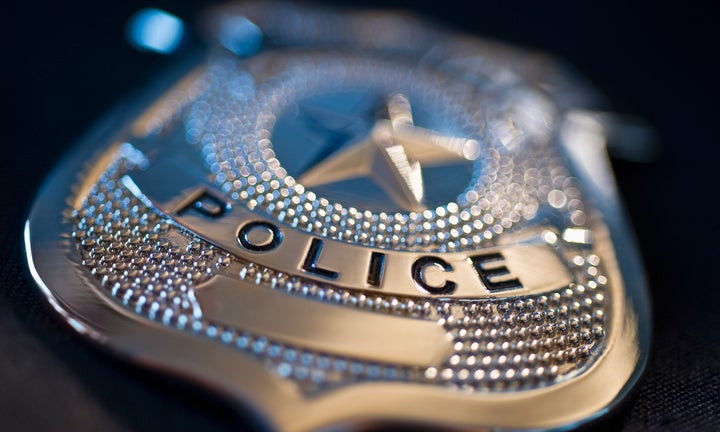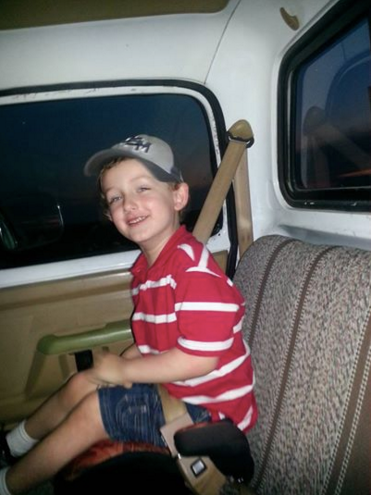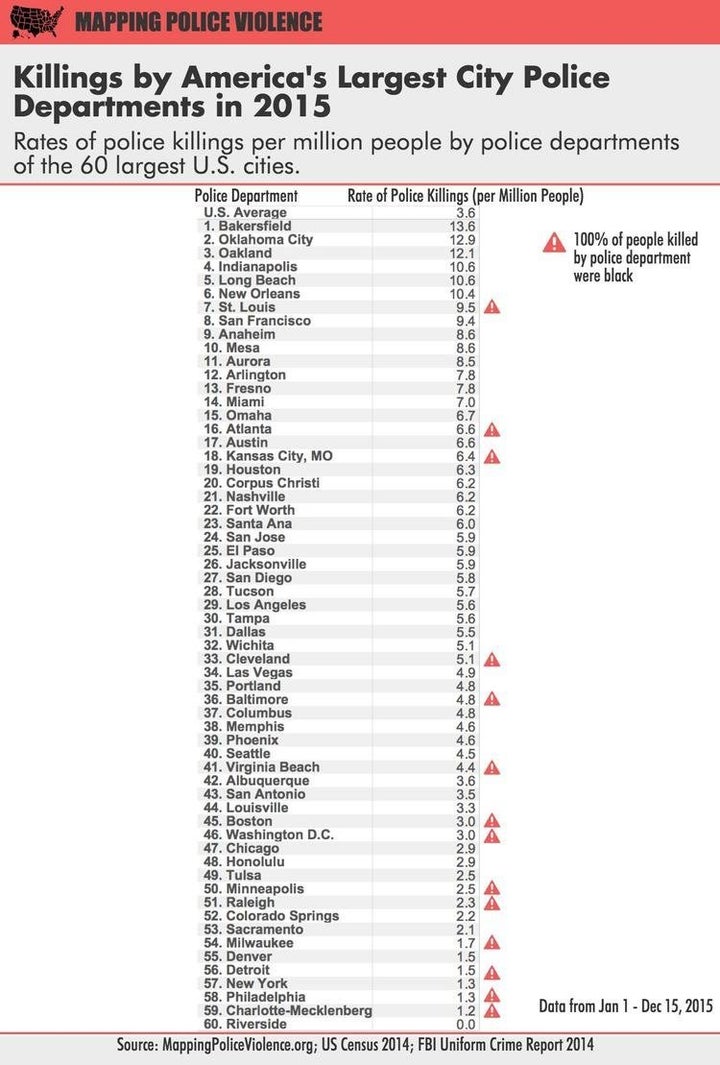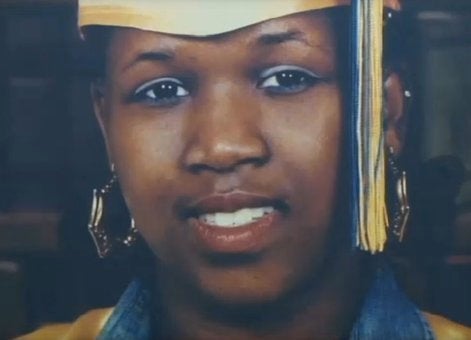
If 2014 was the year many people began asking hard questions about problems with policing, 2015 was the year we started getting answers that showed just how big these problems are.
Motivated by a series of high-profile killings of black males over the last half of 2014 -- and particularly young victims like 18-year-old Michael Brown and 12-year-old Tamir Rice -- the media spent much of 2015 focusing intently on the sorts of complaints that many poorer communities and communities of color had raised.
Incidents that may only have been covered locally in years past continued to get front-page treatment across the country in 2015, bringing with them broader implications for the overall state of law enforcement in the U.S. As a result, the nation got a closer look at the ways bad policing anywhere can corrode the public's trust in the entire institution.
Perhaps most importantly, we realized just how little we had known about trends in police violence and misconduct. In the historic absence of federally collected data on many of the most harrowing statistics, outlets began their own tracking efforts. They came up with a number of reports about the size and scope of controversies in policing. Together, national and local reporting confirmed police departments in the U.S. suffer from a variety of systemic issues.
But we didn't need statistics to see the disturbing patterns evident in the year's most contentious cases. The facts in many police shootings remained sharply contested, long after prosecutors effectively ruled in favor of officers. Official statements sometimes conflicted with the evidence presented to the public. Time and time again, the public was left wondering how shootings that appeared avoidable or unnecessary could also be "justified."
These controversies were further enflamed by a legal system that sometimes operates behind closed doors, asking the public simply to trust that justice was done. And it didn't help that the entire process crawled along at a languid pace that in some cases appeared to be both a function of careful calculation and careless indifference.
While there is hope for incremental police reform heading into 2016, the legal foundations that allow officers and departments to uphold the status quo remain fully intact. To get a better sense of what, if anything, we can expect to change in the new year, here are some numbers from 2015 that you should keep in mind.
1,125
The number of people killed by police in 2015, according to a database compiled by The Guardian.
Because their list includes all manners of death, it counts people who died in police custody, or after being struck by stun guns or police cruisers, as well as those who were shot.
Black civilians were far more likely than people from any other race to be killed by police in 2015, with 6.87 deaths per million people. That's more than two times the rate of Native Americans, the second most likely group, who were killed at a rate of 3.4 per million. The rate among whites was 2.84 deaths per million.
Police in California were involved in the most civilian deaths this year, killing 207 people, according to The Guardian. With the figures adjusted by population, New Mexico saw the highest rate of people dying at the hands of police.

965
The number of people shot to death by police this year, according to a tracking project by The Washington Post.
Ninety of those -- 88 men and 2 women -- were unarmed. Eighteen of the unarmed civilians were Hispanic. With 36 unarmed black victims in 2015, black communities suffered a disproportionately high rate of police violence in this particularly troubling metric as well.
The Post also reported that the large majority of people who police shot and killed were either wielding weapons, experiencing a mental episode or threatening self-harm, or refusing officers' orders. But in 60 percent of cases in which police fired upon civilians exhibiting what the Post calls "less threatening behavior," the suspects were black or Hispanic.
444
The number of people killed by police in "justifiable homicides" in 2014, according to the most recent data from the Federal Bureau of Investigation.
For years, this was the closest figure to an official accounting of civilians killed by police. Now that we have more comprehensive data, it's clear that using the FBI's parameters -- felons killed by officers in the line of duty -- has likely led to a severe undercounting of this statistic.
The FBI announced plans earlier this month to improve its tracking of violent police encounters. By 2017, the agency says, it will be able to provide more information on incidents in which an officer causes serious injury or death to a civilian.
401
The number of days that passed before a prosecutor announced that officers would not face charges in the fatal police shooting of 12-year-old Tamir Rice.
Cuyahoga County Prosecutor Timothy J. McGinty said Monday that a grand jury had determined that two officers were justified in driving up to Rice as he was playing with a toy gun at a park and shooting him within a matter of seconds.
The wait of more than 13 months attracted criticism from the family's lawyers, who repeatedly accused the prosecution of deliberately stalling the case in order to come to a decision that wouldn't hold the officers accountable for the shooting. While the prosecution waited to announce its final conclusion, it courted controversy by releasing a number of findings by independent experts who said they believed officers were justified in opening fire on Rice. The announcement came during the slow stretch between Christmas and New Year's, meaning it's safe to call this a news dump of significant proportions.
Beyond the inevitable questions about whether grand jury reached the correct decision, Rice's case exposes a much broader problem with the often sluggish pace of the legal system responsible for bringing officers to justice in cases such as these.
6
The age of the youngest victim of a fatal police shooting this year. Jeremy Mardis, an autistic boy, was shot by Louisiana police in November.
Mardis was in the car with his father when Marksville city marshals Lt. Derrick Stafford, 32, and Norris Greenhouse Jr., 23, approached and opened fire, discharging at least 18 rounds. Police body camera footage of the incident showed Mardis' father, who was also shot and critically wounded in the incident, with his hands raised at the time of the shooting, according to a lawyer for the family who had viewed the video.
The shooting drew attention to a small-town police force that has been plagued by problem officers, including Stafford and Greenhouse, who had both been named in a number of civil complaints. Other reports suggested there was an escalating turf war between two law enforcement departments in Marksville, and that the two officers may have been given more leeway to patrol the town and issue citations as a result.
Stafford and Greenhouse have been indicted on first-degree murder charges and remain in jail.

8
The number of shots fired at Walter Scott, a 50-year-old black man, as he ran away from North Charleston police officer Michael Slager following a traffic stop in April.
Police initially described the shooting, recorded by a bystander, as a response to a scuffle in which Scott had overpowered Slager and gotten control of the officer's Taser. Slager feared for his life when he pulled the trigger, authorities said. The subsequent release of the video called this narrative into question and quickly led to Slager being charged with murder in the killing. He remains in jail.
The video was played over and over again online and on cable news, once again exposing the power of bystander footage to change the trajectory of a police shooting case -- and leading to further concerns that the death of black people has become a spectacle in U.S. culture.
18
The number of officers charged this year with murder or manslaughter for their involvement in on-duty shootings, according to Philip Stinson, a criminologist at Bowling Green State University who has researched police killings. This includes a number of officers who were charged for incidents that took place in previous years.
The average over the past decade has been closer to five officers charged each year, Stinson said. He believes the increasing presence of bystander video has played a role in the uptick this year.
Stinson, himself a former police officer, told HuffPost earlier this year that the increased attention being paid to police brutality may have also contributed to the rise in prosecution, though he added that it's too early to tell whether 2015 will be a statistical outlier or an early indication of an upward trend. At any rate, he said a handful of charges likely wouldn't eliminate skepticism about the general failure to prosecute police officers.

0
The number of officers convicted this year on murder or manslaughter charges stemming from on-duty incidents.
This serves as a reminder that 15 indictments only looks like progress given the overwhelming resistance to charging police officers -- and that the few officers who do face serious charges for their involvement in police killings are rarely actually punished for their actions.
4
The number of fatal on-duty shooting incidents a single officer has been directly involved in over the course of his career, according to a Washington Post review of police shootings in 2015.
That officer, a sheriff’s deputy on a SWAT team in Broward County, Florida, pulled the trigger in three fatal shootings from 2009 to 2011. In June, he shot for a fourth time during a deadly confrontation with a suspected bank robber.
The Post reported that 55 of the officers who fatally shot civilians this year had previously fired their weapons in other deadly on-duty shootings. A number of others had been involved in two previous incidents.
1
Only one of the nation's 60 largest cities went the entire year without a fatal police shooting, according to a report by Mapping Police Violence, a project headed by activists in the Black Lives Matter movement. That means 59 of the largest 60 cities saw law enforcement kill at least one civilian this year.
Police in Riverside, California, didn't kill a single one of the city's more than 300,000 residents in 2015. About 170 miles north, in Bakersfield, population 360,000, police were ranked the most lethal, killing at a rate of more than 13 people per million, more than three times the national average. They killed a total of five civilians this year.

A separate graph from Mapping Police Violence compares deadly police violence to overall levels of violent crime, and finds that there's no correlation between the two numbers. This knocks down the popular argument that police are more likely to kill people in high-crime areas, ostensibly as a response to a threat posed by a suspect or other members of the community.
In other words, black-on-black crime has nothing to do with police violence.

2
Only two major U.S. cities have fully implemented their police body camera programs, according to a HuffPost review earlier this year.
Among 27 large cities across the nation, only Albuquerque and New Orleans have finished equipping their officers with body cameras. The Justice Department had previously investigated both city police forces over allegations of civil rights violations by their officers.
Many U.S. cities of all sizes have begun to explore police body cameras as a tool for fostering transparency and accountability. The vast majority of departments currently find themselves in the planning stages of their programs, however. Some are still waiting for funding, comparing different devices or testing the use of cameras with a small portion of their officers before rolling out the equipment more widely.
While police and the public tend to agree that body cameras are a good first step toward rebuilding trust between departments and civilians, the slow speed of getting the technology up and running has only exacerbated concerns that police could end up making sure body cameras won't bring about the change many had hoped to see.
400
The number of days it took for Chicago to release a video showing an officer fatally shooting Laquan McDonald, a black 17-year-old who was killed following a confrontation with police.
The publishing of the dashboard camera video followed a lengthy court battle in which authorities reportedly worked to suppress the chilling footage of officer Jason Van Dyke gunning down McDonald in the middle of a busy street. County State's Attorney Anita Alvarez announced first-degree murder charges against Van Dyke shortly after releasing the video. The series of events led some to claim Chicago officials were intent on covering up the incident, and that they might have been successful had a whistleblower not aired concerns that the shooting wasn't going to be adequately investigated.
The footage offered a dramatically different account than the one initially provided by police after the shooting. While officials claimed McDonald had lunged at officers before the shooting, the video -- which police said was recorded without audio -- showed Van Dyke firing the first shot from about 10 feet away and firing the final shot nearly 15 seconds later, as McDonald lay seemingly lifeless on the ground.
Van Dyke was later released on bail that was set at $1.5 million, of which at least 10 percent had to be posted.

0
The number of complaints of biased policing the LAPD sustained between 2012 and 2014, according to a recent Los Angeles Times report. More than 1,300 such complaints were filed over that period.
The figure led officials to admit that something had to be wrong, with one LAPD commissioner telling the Times that it "strains credibility to suggest that ... there were zero instances of biased policing."
Police officials said that the lack of action on these cases is in part due to the difficulty of proving that officers knowingly initiated a civilian interaction because of the civilian's race or other physical factors. But the remarkable record also leads to further questions about whether police should continue to be allowed to investigate themselves if they consistently find that they did nothing wrong.
$248.7 million
The amount paid out last year by the 10 largest U.S. cities for settlements and court judgments involving police misconduct cases in their departments, according to a Wall Street Journal report. These cities paid out more than $1 billion over five years, with the annual total increasing nearly 50 percent from 2010 to 2014.
Taxpayers in these cities are typically on the hook for these payments, meaning that they can end up getting victimized twice -- both as the direct casualties of police misconduct and the unwilling enablers who must eventually pay for that misconduct.
$5.7 million
The amount Baltimore taxpayers shelled out in police misconduct cases between 2011 and September 2014, when the Baltimore Sun published an explosive report on excessive force by the city's police department.
As the Sun reported, that money "would cover the price of a state-of-the-art rec center or renovations at more than 30 playgrounds." And this doesn't include the nearly $6 million the city spent defending officers against these claims.
This money could have gone to much better causes in other cities as well. In Chicago, for example, the $521 million taxpayers coughed up in police misconduct cases between 2004 and 2014 would have been enough for the city to cover nearly the entire cost of a new, state-of-the-art research hospital being built downtown.
34
The number of officers killed in attacks suffered in the line of duty this year, according to an independent count compiled by the Officer Down Memorial Page, a website that tracks law enforcement deaths.
That makes 2015 one of the safest years on record for law enforcement. In 2013, the safest year in documented history, 27 officers were killed as a result of felonious acts, according to the FBI.
While critics tried to combat the increasingly vocal push for police reform by branding this activism as a "war on cops," it's now clear this claim was bogus. Police may have felt like they were "under attack" -- it's difficult to hear public criticism when you have so long been insulated from it, after all -- but these were never physical threats. Data shows that non-lethal violence against police is also on the decline.
And if this so-called "war on cops" was supposed to be coupled with an increase in crime because officers were too scared to do their jobs, that also didn't pan out. While some cities did see disturbing increases in murder rates, the overall rate of violent crime and murder -- including in many of those same cities -- has still been in decline for the last 25 years. That trend is projected to have continued in 2015.
Let's all remember that as we talk about policing and the pressing need for reform in 2016.
CORRECTION: A previous version of this story contained an outdated figured for the number of police officers charged with murder or manslaughter this year.
Also on HuffPost:
CORRECTION: A previous version of this story contained an outdated figure for the number of police officers charged with murder or manslaughter this year. There have been at least 18 so far in 2015.

